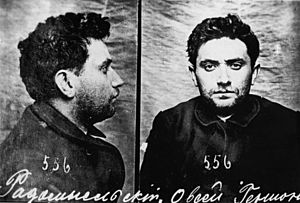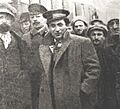Grigory Zinoviev facts for kids
Quick facts for kids
Grigory Zinoviev
|
|
|---|---|
|
Григорий Зиновьев
|
|
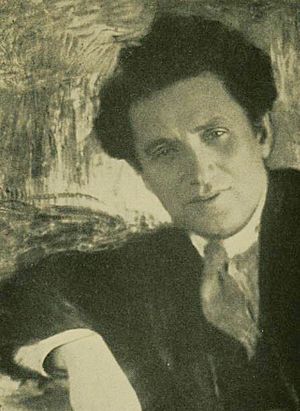
Zinoviev in 1920
|
|
| Chairman of the Communist International | |
| In office 2 March 1919 – 22 November 1926 |
|
| Preceded by | Position created |
| Succeeded by | Nikolai Bukharin |
| Chairman of the Petrograd Soviet | |
| In office 13 December 1917 – 26 March 1926 |
|
| Preceded by | Leon Trotsky |
| Succeeded by | Office abolished |
| Full member of the 6th, 10th, 11th, 12th, 13th, 14th Politburo | |
| In office 10 October – 29 November 1917 |
|
| In office 16 March 1921 – 2 June 1924 |
|
| Candidate member of the 8th, 9th Politburo | |
| In office 25 March 1919 – 16 March 1921 |
|
| Personal details | |
| Born |
Ovsei-Gershon Aronovich Radomyslsky
23 September 1883 Yelizavetgrad, Russian Empire (now Kropyvnytskyi, Ukraine) |
| Died | 25 August 1936 (aged 52) Moscow, Russian SFSR, Soviet Union |
| Cause of death | Execution by shooting |
| Nationality | Russian (1883–1936) Soviet (1917–1936) |
| Political party | RSDLP (1901–1903) RSDLP (Bolsheviks) (1903–1918) Russian Communist Party (Bolsheviks) (1918–1927, 1928–1932, 1933–1934) |
Grigory Zinoviev (born Ovsei-Gershon Aronovich Radomyslsky, 23 September 1883 – 25 August 1936) was an important figure in the early Soviet Union. He was a revolutionary and politician who worked closely with Vladimir Lenin, a key leader of the Bolsheviks. During the 1920s, Zinoviev was one of the most powerful people in the Soviet government. He also led the Communist International, an organization that aimed to spread communism worldwide.
Zinoviev was born in Ukraine to a Jewish family. He became involved in revolutionary activities in 1901. He joined the Russian Social Democratic Labour Party (RSDLP), which later split into two groups: the Mensheviks and the Bolsheviks. Zinoviev chose to join Lenin's group, the Bolsheviks. He was known for being very loyal to Lenin.
After the Bolsheviks took power in the October Revolution of 1917, they formed their own government. This led to the Russian Civil War. Zinoviev was put in charge of the Communist International in 1919. This group helped new communist movements in other countries. However, Zinoviev's efforts to start revolutions abroad were not successful.
Later, when Lenin became very ill, Zinoviev teamed up with Lev Kamenev and Joseph Stalin. They worked together against Leon Trotsky, another powerful leader. This alliance helped remove Trotsky from power. But after Trotsky was defeated, Stalin and Zinoviev started to disagree. Zinoviev was even kicked out of the Communist Party several times.
Zinoviev's disagreements with Stalin led him to work with Trotsky and Kamenev again. In 1934, a close friend of Stalin, Sergei Kirov, was killed. An investigation claimed that Zinoviev was involved in a plot against Stalin. He was arrested and put on trial in 1936. Zinoviev and others were found guilty and sentenced to death. He was executed on August 25, 1936. Years later, in 1988, he was officially cleared of the charges.
Contents
- Grigory Zinoviev: A Key Figure in Soviet History
- Early Life and Revolutionary Beginnings
- The Russian Revolutions of 1917
- Leading During the Civil War (1918–1920)
- Rising to Power (1921–1923)
- Working with Stalin Against Trotsky (1923–1924)
- Disagreements with Stalin (1925)
- Joining Forces with Trotsky Against Stalin (1926–1927)
- Returning to the Party (1928–1934)
- The Moscow Trials and Execution (1935–1936)
- The "Zinoviev Letter"
- See also
- Works
- Images for kids
Grigory Zinoviev: A Key Figure in Soviet History
Early Life and Revolutionary Beginnings
Grigory Zinoviev was born in Yelizavetgrad, Russian Empire (now Kropyvnytskyi, Ukraine). His family were Jewish dairy farmers. He was educated at home and his birth name was Ovsei-Gershon Aronovich Radomyslsky. The city where he was born was even called Zinovyevsk for a time, from 1924 to 1934.
Zinoviev studied philosophy, literature, and history. He became interested in politics and joined the Russian Social Democratic Labour Party (RSDLP) in 1901. When the RSDLP split in 1903, he joined the Bolshevik group. This group was led by Vladimir Lenin.
From 1903 until 1917, Zinoviev was a leading Bolshevik. He was one of Lenin's closest helpers. He worked both inside Russia and in other countries. In 1907, he was chosen to be part of the RSDLP's Central Committee. He stayed loyal to Lenin and represented him in different socialist groups until 1917.
The Russian Revolutions of 1917
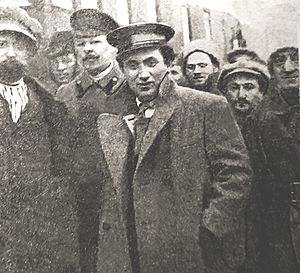
Zinoviev spent the first part of World War I in Switzerland. After the Russian monarchy was overthrown in the February Revolution of 1917, he returned to Russia. He traveled with Lenin and other revolutionaries. He remained a part of the Bolshevik leadership for most of that year.
However, Zinoviev and Lenin had a disagreement. Zinoviev did not agree with Lenin's plan for an armed uprising against the government. On October 10, 1917, he and Lev Kamenev were the only two members of the Central Committee to vote against it. Lenin was very angry and wanted them removed from the party.
After the Bolsheviks took power in the October Revolution, some railway workers threatened a strike. Zinoviev and Kamenev thought the Bolsheviks should share power with other socialist parties. They even resigned from the Central Committee for a short time. Lenin called them "deserters" because of this.
Leading During the Civil War (1918–1920)

Zinoviev soon rejoined the Bolshevik party. He was elected to the Central Committee again in March 1918. He was put in charge of the city and regional government of Petrograd (now Saint Petersburg).
During this time, a period of political repression called the Red Terror began. Zinoviev spoke about the need to defeat enemies of the revolution. He became a non-voting member of the ruling Politburo in March 1919. He also became the Chairman of the Executive Committee of the Communist International (Comintern).
The Comintern was created to help spread communist ideas around the world. Zinoviev led important meetings for this organization. He was also responsible for defending Petrograd during battles with anti-Bolshevik forces in 1919.
Rising to Power (1921–1923)
In early 1921, the Communist Party had different groups with different ideas. Zinoviev supported Lenin's group. Because of this, he became a full member of the Politburo in March 1921. Other members who disagreed with Lenin were removed.
Zinoviev became one of the most important people in the Soviet leadership. This happened during Lenin's final illness in 1922–23 and after Lenin's death in 1924. Zinoviev gave important reports at Party Congresses, a role Lenin used to have. He was also seen as a leading thinker in the Communist Party.
The Comintern's main goal was to make sure other communist parties supported the Soviet Union's foreign policy. It watched over many national parties and made them more like the Soviet system.
Working with Stalin Against Trotsky (1923–1924)
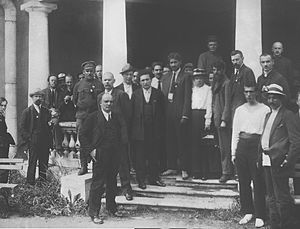
When Lenin was very ill, Zinoviev, Kamenev, and Joseph Stalin formed a powerful group. This group was called the 'triumvirate' or 'troika'. They worked together to reduce the power of Leon Trotsky. They carefully controlled party discussions and elections.
In January 1924, just before Lenin died, a Party Conference criticized Trotsky. Many of Trotsky's supporters lost their positions. Zinoviev's power seemed to be at its highest point. However, his real power was mostly limited to the party in Petrograd. Stalin was gaining more control over the rest of the Communist Party.
After Trotsky's defeat, Zinoviev and Kamenev started to have disagreements with Stalin. But they still helped Stalin keep his job as General Secretary of the Central Committee in May–June 1924.
Later in 1924, Trotsky wrote about the events of 1917. He mentioned Zinoviev's and Kamenev's opposition to the Bolshevik takeover. This caused a new fight within the party. Zinoviev and Kamenev again joined Stalin against Trotsky. They accused Trotsky of many mistakes during the Russian Civil War. Trotsky was forced to resign from his military roles in January 1925. Zinoviev wanted Trotsky kicked out of the party, but Stalin did not agree at that time.
Disagreements with Stalin (1925)
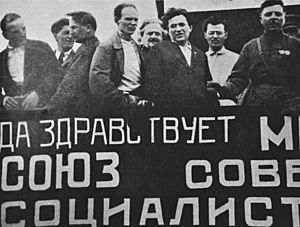
After Trotsky was no longer a threat, the alliance between Zinoviev, Kamenev, and Stalin began to fall apart in 1925. Stalin formed a new alliance with Nikolai Bukharin and Alexei Rykov. Zinoviev and Kamenev teamed up with Lenin's widow, Nadezhda Krupskaya.
The struggle became public at the Party Congress in December 1925. Zinoviev and Kamenev had very little support and were defeated. Zinoviev was re-elected to the Politburo, but Kamenev lost his full membership. Stalin gained more allies in the Politburo. Within weeks, Stalin took control of the Leningrad party from Zinoviev. Zinoviev lost all his regional jobs, leaving only the Comintern as his power base.
Joining Forces with Trotsky Against Stalin (1926–1927)
In 1926, Zinoviev, Kamenev, and their supporters joined forces with Trotsky's supporters. This alliance was called the United Opposition. Stalin told his supporters to focus their attacks on Zinoviev. He knew Zinoviev understood his methods well.
Zinoviev was accused of using the Comintern for his own group's activities. He was removed from the Politburo in July 1926. Soon after, the position of Comintern Chairman was removed, and Zinoviev lost his last important job.
Zinoviev continued to oppose Stalin in 1926 and 1927. This led to his removal from the Central Committee in October 1927. When the United Opposition tried to hold their own demonstrations, they were stopped by force. Zinoviev and Trotsky were expelled from the Communist Party in November 1927. Their main supporters were also expelled in December 1927.
Returning to the Party (1928–1934)
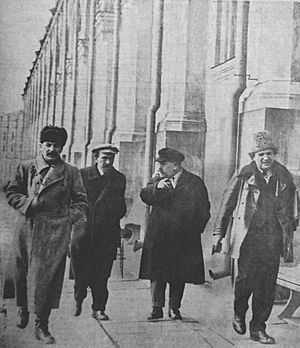
While Trotsky remained firmly against Stalin, Zinoviev and Kamenev quickly gave in. They wrote letters admitting their mistakes. They were allowed back into the Communist Party after six months. However, they never got their Central Committee seats back. They were given less important jobs in the government.
They were forced to give speeches at the Party Congress in January 1934. In these speeches, they admitted their supposed mistakes. Stalin showed them off as defeated opponents.
The Moscow Trials and Execution (1935–1936)
After Sergei Kirov was murdered in December 1934, Zinoviev, Kamenev, and their closest friends were again expelled from the party and arrested. In January 1935, they were put on trial. They were forced to admit they were "morally involved" in Kirov's death. Zinoviev was sentenced to 10 years in prison.
In August 1936, Zinoviev, Kamenev, and 14 others were put on trial again. This trial was called the Trial of the Sixteen. They were accused of forming a terrorist group that killed Kirov and tried to kill Stalin. This was the first of the famous Moscow Trials. In these trials, old Bolsheviks confessed to crimes they did not commit.
Zinoviev and the other people on trial were found guilty on August 24, 1936. Before the trial, Zinoviev and Kamenev had agreed to say they were guilty. They were told they would not be executed. But a few hours after they were found guilty, Stalin ordered their execution. On August 25, 1936, Grigory Zinoviev and Lev Kamenev were executed by a firing squad.
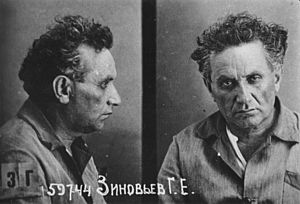
The execution of Zinoviev and Kamenev was a huge news event. It led to many more arrests and executions during the Great Purge of 1937–1938. In 1988, during a time of change in the Soviet Union, Zinoviev and the others were officially cleared of the charges.
The "Zinoviev Letter"
The "Zinoviev Letter" was a document that caused a big stir in the United Kingdom. It was published on October 25, 1924, just before a general election. The letter supposedly called on British Communists to prepare for a revolution.
However, it is now widely believed that this letter was a fake. Zinoviev himself said it was a forgery in a letter dated October 27, 1924. He pointed out mistakes in the letter's heading and signature. He also said the date was wrong because he was on holiday at the time.
Zinoviev believed the letter was created to confuse voters. He thought it was meant to harm relations between England and the Soviet Union.
See also
 In Spanish: Grigori Zinóviev para niños
In Spanish: Grigori Zinóviev para niños
- Foreign relations of the Soviet Union
- Moscow Trials
Works
- Boi za Peterburg: Dve Rechi (The Fight for St. Petersburg: Two Speeches). With Leon Trotsky. St. Petersburg: Gosudarstvennoe Izdatel'stvo, 1920.
- Leninizm: Vvedenie i izuchenie Leninizma (Leninism: Introduction to the Study of Leninism). Leningrad: Gosudarstvennoe Izdatel'stvo, 1925.
Images for kids
-
The leadership of the USSR, April 1925. In the photo, taken in the Kremlin: Joseph Stalin, General Secretary of the Communist Party; Alexei Rykov, Chairman of the Council of People's Commissars (Prime Minister); Lev Kamenev, Deputy Chairman of the Council of People's Commissars (Deputy Prime Minister); Grigory Zinoviev, Chairman of the Comintern's Executive Committee


